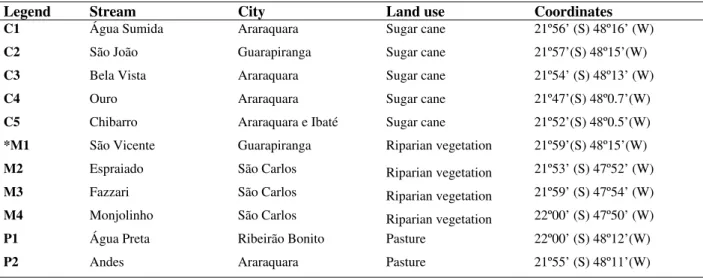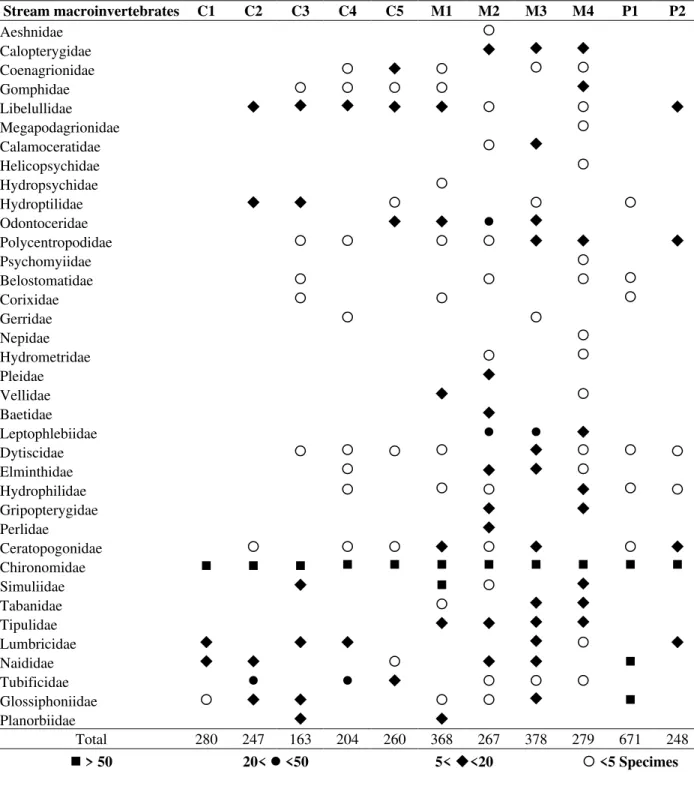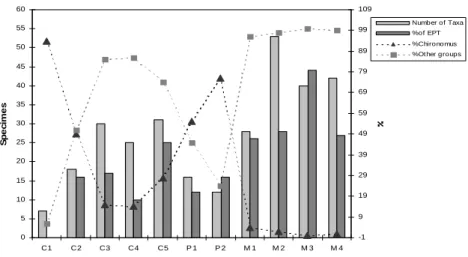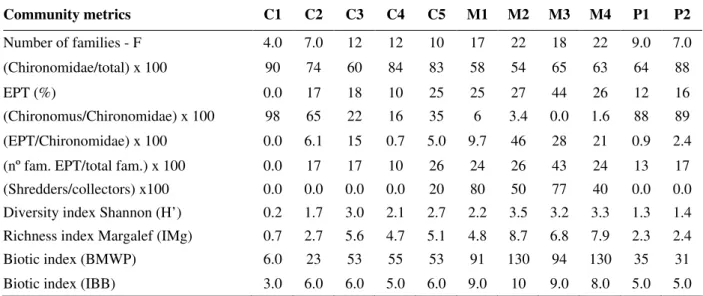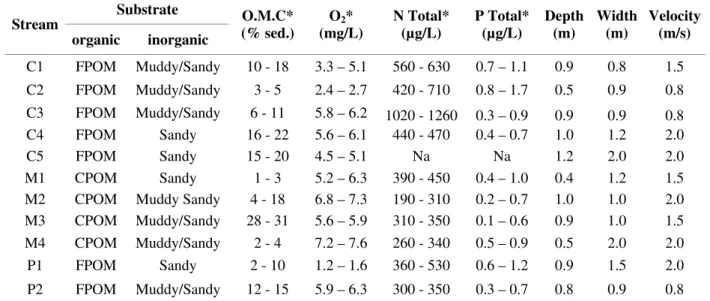Vol. 51, n. 4 : pp.769-779, July-Aug 2008
ISSN 1516-8913 Printed in Brazil BRAZILIAN ARCHIVES OF
BIOLOGY AND TECHNOLOGY
A N I N T E R N A T I O N A L J O U R N A L
Relationship between Sugar Cane Cultivation and Stream
Macroinvertebrate Communities
Juliano José Corbi1* and Susana Trivinho-Strixino1
1
Laboratório de Entomologia Aquática; Departamento de Hidrobiologia; Universidade Federal de São Carlos, C.P.: 676; julianocorbi@yahoo.com.br; São Carlos - SP - Brasil
ABSTRACT
The aim of this work was to study the influence of the sugar cane cultivation on the macroinvertebrate communities of 11 streams under different land uses. Analysis of the sediment (organic matter contents and metals) and water complemented the study. Ninety six macroinvertebrates taxa were identified, of which 54 were Chironomidae and 42 of other aquatic macroinvertebrates. The streams located in the areas of sugar cane culture and pasture presented low taxa and a great participation of Chironomidae (78% of the total). In contrast, the streams located in the areas with riparian vegetation presented a rich aquatic fauna with less participation of Chironomidae (60% of the total).
Keywords: Stream macroinvertebrates, sugar cane, land uses, riparian vegetation
*Author for correspondence INTRODUCTION
Brazilian colonization occurred without a specific planning and, as a consequence, natural resources, particularly forests, were greatly affected, especially by the economic interests. In the Brazilian history, the native land cover vegetation was removed and substituted by the agriculture, mainly of the sugar cane and also pastures. These processes result in deforestation, especially in the Brazilian southeast region (Martins, 2001). In Brazil, the sugar cane cultivation passed for different periods, always presenting an increasing cultivated area. From 1901 to 1950, the production increased five times. From 1950 to 1970, the cultivated area quadruplicated. In 1975, with the implantation of the Proalcohol Program, the production of the sugar cane grew up from 68 million tons/year to 223 million tons in the year of
1991 (Carvalho, 1993). In the last 15 years, sugar cane cultivation still continues to expand, reaching more than 338 million of tons (Carvalho Filho, 2000). Brazil is the main producer of the sugar cane, with 27% of the worldwide production (Institute of Agro-industrial Development, 1998). In Brazil, the sugar cane is the main source of sugar (sucrose) and for alcohol production through a fermentative process. The produced alcohol is exported to other countries and also is used as an alternative and renewable combustible for transport (Carvalho Filho, 2000). In the southeast Brazilian region, mainly in the state of São Paulo, the sugar cane culture has also been enlarged. The annual production of the state of São Paulo is of
about 200x106 tons covering an area of 2.5x106 ha.
periods of the cultivation of the sugar cane, in addition to the deforestation of the riparian vegetation, have caused impacts on the hydric resources of the adjacent areas. These impacts are caused in general by the absence of the riparian vegetation, which is responsible for absorption of the toxic products that come from the cultivated areas (Dudgeon, 1989; Nery, 2000; Martins, 2001; Primavesi et al., 2002; Angelotti-Netto et al., 2004). Moreover, in the absence of the riparian shading, light-related factors have influenced indirectly the primary production of the streams and, consequently, the composition of the
periphyton (Mosisch, et al., 2001; Bojsen and
Jacobsen, 2003). Studies with the objective of detection of possible impacts of the sugar cane cultivation in waters of rivers, streams and lakes have demonstrated that mainly in opened areas (without riparian vegetation), chemical toxic products (fertilizers and insecticides) used in the sugar cane culture are carried out to the streams, through a runoff process, contaminating the water and sediments (Corbi et al., 2006) and causing bioaccumulation in different trophic levels (Santos, 1999; Oliveira and Tornisielo, 2000; Angelotti-Netto et al., 2004). According to the Brazilian federal laws, the areas with the riparian vegetation are classified as a permanent preservation area. In this context, knowledgement about the relationship between the sugar cane cultivation and its influence on the stream macroinvertebrate communities is of high importance for Brazilian sustainable development (Ometo et al., 2000; Roque and Trivinho-Strixino, 2001). In the present work, the influence of the agricultural activity, in particular the sugar cane culture, on stream macroinvertebrate communities was studied.
MATERIALS AND METHODS
Study sites
The 11 streams analyzed are all located on Jacaré-Guaçu River Basin, state of São Paulo, Brazil (Table 1). All streams are of low order and are located at low altitude from 500 to 700m. The average annual precipitation in the Jacaré-Guaçu River basin is about 1400 mm. The wet season occurs between October and March, while dry season occurs from April to September. Sites C1 to C5 are located in the extensive areas with the
sugar cane cultivation. Sites M2 to M4 are located on the areas with forested areas and M1 in the area with impacted riparian vegetation. Sites P1 and P2 are located in the pasture areas, without riparian vegetation.
Macroinvertebrate communities
Macroinvertebrates were surveyed in three coincident periods of the three stages of the sugar cane cultivation (plantation, cut, pos-cut): March/April, 2002; June/July/August, 2002; November/December, 2002. Thirty three samples were collected: 15 in the streams with the sugar cane culture, 12 in the streams with the riparian vegetation and 6 in the pasture areas. The macroinvertebrates were collected using a D-frame (Merrit and Cummins, 1996) aquatic net (250 µm) including riffle and pools areas, during 5 minutes, as recommended by Fontoura (1985). Three collections were combined into a single collection at each site. Samples were taken to the laboratory, washed in a sieve of 0.21mm of mesh, selected on illuminated tray and fixed with 70% alcohol. The insects were dominant and the taxonomic identification was achieved at family level for most of them on the basis of the available published data (Brinkhurst and Marchese, 1991; Merritt and Cummins, 1984). Larvae of Chironomidae (Diptera) were analyzed until the morfotypes (Trivinho-Strixino and Strixino, 1995).
Physical and chemical characterization
Table 1 - Streams localization and general information about land uses.
Data analysis
In the state of São Paulo, there is no index correlating the macroinvertebrate communities and the local environment, or any water-quality index using the benthic fauna (Ometo et al., 2000). Moreover, many assessment techniques adopt a multimetric approach using a suite of simple metric to assess environmental degradation. The strength of this approach lies in its ability to integrate information from the various features of a community to give an overall classification of degradation without losing the information provided by individual metrics (Thorne and Williams, 1997). Consequently, in this study, the stream macroinvertebrates were analyzed by the participation of each taxonomic group and for the total of organisms collected. In order to evaluate the integrity of each stream, the community characteristics were determined by the following metrics: richness index (Margalef), diversity index (Shannon), BMWP (with regional adaptations) and
Belgian Biotic Index, EPT percentage
(Ephemeroptera, Plecoptera and Trichoptera), ratio (%) of the number of EPT families by the total number of macroinvertebrate families (EPT/total of families X 100), ratio between the number of EPT (sensitive) and Chironomidae (tolerant) (EPT/Chironomidae X 100), ratio between the Chironomidae number and the total of individuals collected (Chironomidae/total X 100), ratio
between the number of Chironomus larvae and the
total Chironomidae number (Chironomus /
Chironomidae) and the ratio between the amount
of shredders and collectors (shredders/collectors x 100) according to Merrit and Cummins classification (1984). The Estimates Program (Version 6), to calculate the richness index (Margalef) and the diversity index (Shannon) was used.
An analysis of variance Kruskal-Wallis (ANOVA) was applied for the bioavailable metals to detect significance differences between the streams. The Statistic program (version 5.0) was used to perform this statitistical analysis.
RESULTS
Macroinvertebrate communities
In this study, 3365 organisms of 37 families of macroinvertebrates were analyzed (Table 2). In all the streams, the Chironomidae (Diptera) dominated the macroinvertebrates fauna, with 70% of the total of the collected macroinvertebrates (from 54% in the Espraiado stream to 90% in the Água Sumida stream) (Table 3). Other taxonomic
groups like Libellulidae, Dytiscidae,
Ceratopogonidae and Polycentropodidae were also frequently observed, with more than 60% of occurrence in all the streams. In the streams without cover vegetation, especially in those located next to the sugar cane cultivation, a high amount of Odonata (Libellulidae family) and of Annelida, including the families Tubicidae, Naididae and Lumbricidae (Oligochaeta) and Glossiphoniidae (Hirudinea) was observed. The
Legend Stream City Land use Coordinates
C1 Água Sumida Araraquara Sugar cane 21º56’ (S) 48º16’ (W)
C2 São João Guarapiranga Sugar cane 21º57’(S) 48º15’(W) C3 Bela Vista Araraquara Sugar cane 21º54’ (S) 48º13’ (W)
C4 Ouro Araraquara Sugar cane 21º47’(S) 48º0.7’(W)
C5 Chibarro Araraquara e Ibaté Sugar cane 21º52’(S) 48º0.5’(W)
*M1 São Vicente Guarapiranga Riparian vegetation 21º59’(S) 48º15’(W) M2 Espraiado São Carlos Riparian vegetation 21º53’ (S) 47º52’ (W)
M3 Fazzari São Carlos Riparian vegetation 21º59’ (S) 47º54’ (W)
M4 Monjolinho São Carlos Riparian vegetation 22º00’ (S) 47º50’ (W)
P1 Água Preta Ribeirão Bonito Pasture 22º00’ (S) 48º12’(W)
P2 Andes Araraquara Pasture 21º55’ (S) 48º11’(W)
streams protected by the riparian vegetation showed a great variety of groups such as the Ephemeroptera, Plecoptera and Trichoptera
families, and also the Diptera of the Tipulidae and Tabanidae families (Table 2).
Table 2 - Macroinvertebrates of the streams.
Stream macroinvertebrates C1 C2 C3 C4 C5 M1 M2 M3 M4 P1 P2
Aeshnidae
Calopterygidae
Coenagrionidae
Gomphidae
Libelullidae
Megapodagrionidae
Calamoceratidae
Helicopsychidae
Hydropsychidae
Hydroptilidae
Odontoceridae
Polycentropodidae
Psychomyiidae
Belostomatidae
Corixidae
Gerridae
Nepidae
Hydrometridae
Pleidae
Vellidae
Baetidae
Leptophlebiidae
Dytiscidae
Elminthidae
Hydrophilidae
Gripopterygidae
Perlidae
Ceratopogonidae
Chironomidae
Simuliidae
Tabanidae
Tipulidae
Lumbricidae
Naididae
Tubificidae
Glossiphoniidae
Planorbiidae
Total 280 247 163 204 260 368 267 378 279 671 248
> 50 20< <50 5< <20 <5 Specimes
Among the 54 Chironomidae taxa identified, 37 of them were observed in the forested streams. In the sugar cane and pasture areas, 32 and 11 taxa were
analyzed, respectively. Among the 54
Chironomidae, Chironomus spp. larvae, together
with Rheotanytarsus spp., Ablabesmyia gr.
areas, there was a numeric dominance of Chironomus spp., Ablabesmyia spp. and Procladius sp. larvae. In contrast, in the forested areas, there was a major richness of taxa, and Beardius sp., Stenochironomus spp., Endotribelos spp. and Caladomyia spp. larvae were the organisms exclusive of these systems. (Table 4). The values of the community index (richness
index Margalef - IMg, diversity index Shannon - H’
and families richness – F) were high in the streams with the riparian vegetation, except in the São Vicente stream (M1), which presented low diversity (see Table 3). In contrast, the Bela Vista stream (C3), situated in an area of the sugar cane cultivation, presented higher diversity index than
other areas located in the agricultural activity (opened areas). Among these indexes, the family richness (F) showed high differences. The values of the ratio between the shredders and the collectors specimes also showed great differences between streams located on preserved areas and deforested areas (sugar cane and pasture).
An interesting observation was the high percentages of sensitive taxa (EPT) and the ratio Chironomus/other groups in streams located in the preserved areas (Fig. 1). The biotic index (BMWP and IBB) applied to 11 streams showed a good water quality in the preserved ones (M1-M4) while in the streams with the agricultural activity and pasture a low water quality was observed.
Figure 1 - General information about some metrics applied for the aquatic macroinvertebrates of
the studied streams.
Water and sediment composition
Total nitrogen and total phosphorus presented high values in the streams under influence of the sugar cane activity. Total nitrogen (Total N) changed from 190 µg/L in the Espraiado Stream (with riparian vegetation) to 1260 µg/L in the São João Stream (with the sugar cane culture); total phosphorus (Total P) presented low values in all streams, with a minimum of 0.1 µg/L in the Fazzari Stream (with riparian vegetation) to the maximum of 1.7 µg/L in the São João Stream (with sugar cane culture). Dissolved oxygen (O2) also presented low concentrations in the streams with pasture and sugar cane culture, varying from 1.2 mg/L in the Água Preta Stream (with pasture) to 7.6 mg/L in the Monjolinho Stream (with riparian vegetation). The pH values in all streams were in the range 6-7. Concentrations of these
components, as well as measurements of other physical and chemical characteristics, are presented in Table 5.
The metal concentrations (Cu, Zn, Cd, Fe, Cr, Ni and Mn) presented elevated values in the streams with the sugar cane culture and pasture when compared to the streams located in the forested areas. The statistical test of Kruskal-Wallis (ANOVA) applied for the bioavailable metal values showed significance differences for Cu and Zn (P< 0.05) between the streams in the sugar cane and preserved areas. Fe presented significative differences (P<0.05) between the streams located in the pasture and preserved areas. The Mn, Cr, and Ni metals did not present significance differences. More detailed discussions of this analysis are shown in Corbi et al. (2006).
0 5 10 15 20 25 30 35 40 45 50 55 60
C1 C2 C3 C4 C5 P 1 P 2 M 1 M 2 M 3 M 4
S
p
e
c
im
e
s
-1 9 19 29 39 49 59 69 79 89 99 109
Table 3 - Summary of the main community characteristics and evaluation measurements of the streams.
Community metrics C1 C2 C3 C4 C5 M1 M2 M3 M4 P1 P2
Number of families - F 4.0 7.0 12 12 10 17 22 18 22 9.0 7.0
(Chironomidae/total) x 100 90 74 60 84 83 58 54 65 63 64 88
EPT (%) 0.0 17 18 10 25 25 27 44 26 12 16
(Chironomus/Chironomidae) x 100 98 65 22 16 35 6 3.4 0.0 1.6 88 89 (EPT/Chironomidae) x 100 0.0 6.1 15 0.7 5.0 9.7 46 28 21 0.9 2.4 (nº fam. EPT/total fam.) x 100 0.0 17 17 10 26 24 26 43 24 13 17 (Shredders/collectors) x100 0.0 0.0 0.0 0.0 20 80 50 77 40 0.0 0.0 Diversity index Shannon (H’) 0.2 1.7 3.0 2.1 2.7 2.2 3.5 3.2 3.3 1.3 1.4 Richness index Margalef (IMg) 0.7 2.7 5.6 4.7 5.1 4.8 8.7 6.8 7.9 2.3 2.4
Biotic index (BMWP) 6.0 23 53 55 53 91 130 94 130 35 31
Biotic index (IBB) 3.0 6.0 6.0 5.0 6.0 9.0 10 9.0 8.0 5.0 5.0
Table 4 - Chironomidae of the streams.
Chironomidae C1 C2 C3 C4 C5 M1 M2 M3 M4 P1 P2
Ablabesmyia gr. annulata sp.
Ablabesmyia (Karellia) sp.
Alotanypus (?)sp.
Clinotanypus sp.
Coelotanypus sp.
Djalmabatista sp. 1
Djalmabatista sp. 2
Fittkauimyia sp.
Labrundinia sp.
Larsia sp.
Macropelopia (?) sp.
Pentaneura sp.
Procladius sp.
Thienemannimyia sp.
Zavrelimyia sp.
Beardius sp.
Chironomus spp.
Cladopelma sp.
Cryptochironomus sp.
Endotribelos sp. 1
Endotribelos sp. 2
(cont. Table 4)
Chironomidae C1 C2 C3 C4 C5 M1 M2 M3 M4 P1 P2
Endotribelos sp. 3
Fissimentum sp.
Goeldichironomus sp.
Harnischia (complexo) spp.
Lauterborniella sp.
Nilothauma sp.
Oukuriella sp.
Paratendipes sp.
Polypedilum spp.
Stenochironomus spp.
Zavreliella sp.
Caladomyia sp. 1
Caladomyia sp. 2
Rheotanytarsus spp.
Stempellinella sp.
Stempellina sp.
Tanytarsus sp. 1
Tanytarsus sp. 2
Tanytarsus sp. 3
Tanutarsus sp. 4
Tanytarsus sp. 5
Tanytarsus sp. 6
Tanytarsus sp. 7
Cardiocladius sp.
Cricotopus sp.
Corynoneura sp.
Gymnometriocnemus sp.
Lopescladius sp.
Nanocladius sp.
Parakiefferiella sp.
Parametriocnemus sp.
Thienemanniella sp. 1
Thienemanniella (?) sp. 3
Table 5 - General features of the streams. O.M.C (organic matter content); O2 (dissolved oxygen)
Na: not analyzed. * Minimum and maximum values for the period of study.
DISCUSSION
Inputs from the riparian sources, in the form of dissolved organic matter, leaf litter, fruits, woody debris and invertebrates, are recognized as important food resources for aquatic food webs in many systems (Lynch et al., 2002). Several studies have shown the importance of the riparian canopy for the stream macroinvertebrate community’s distribution (Dudgeon, 1989; Cummins et al., 1989; Bilby and Bisson, 1998; Sponseller et al., 2001; Mosisch et al., 2001; Ferreira-Peruqueti and Fonseca-Gessner, 2003; Benstead and Pringle, 2004; Goulart and Callisto, 2005). Bojsen and
Jacobsen (2003) and Kay et al. (2001) showed that
the reduction of the riparian canopy cause a decrease of litter detritus on the streambed and an increase of periphyton biomass, because of the light-related factors. In these streams, the
macroinvertebrate communities were
homogeneous and depauperate, in contrast with those of forested areas.
Our results showed clearly the importance of the riparian vegetation, which provided major taxa richness in the forested streams (M1 - M4), with exception of the São Vicente stream (M1). For this stream, the proximity with the sugar cane culture and the continuous loss in the last years of the riparian vegetation probably influenced the minor richness.
Cummins et al. (1989) have also shown the importance of the riparian canopy as the main
factor of increment of the shredders insects. Our results indicated that the larvae of Trichoptera (Calamoceratidae and Odontoceridae) and Diptera (Tipulidae), together with Chironomidae larvae of Stenochironomus spp., Endotribelos spp. and Oukuriella sp., all shredders, were exclusively from the forested streams. Other important aspect was the high participation of the Libelullidae larvae (predators) on the sugar cane streams. Ferreira-Peruquetti and Fonseca-Gessner (2003) observed similar results in their study about the Odonata community in the areas with Cerrado vegetation and sugar cane culture in the state of São Paulo. Nevertheless, the Libelullidae family was also observed in high quantities in the pasture area (P2 stream). Therefore, the occurrence of this group seemed to be more related with the deforestation of the riparian vegetation than to the sugar cane activity.
Many streams in São Paulo are located in a Cerrado vegetation area at low altitudes and with sand substrates. As a result, a dominance of the Chironomidae fauna is observed (Roque and Trivinho-Strixino, 2001; Freire and Gessner, 2002). This fact was also observed in the present study. In contrast, a large number of Chironomus
spp. larvae, observed in the deforested streams, is
an indicative of the environmental impact caused by the sugar cane cultivation and pasture activity. The larvae of this genus are known as commonly tolerant taxa of the urban and industrial discharge (Roque et al., 2000; Peláez-Rodriguez, 2001; Kleine and Trivinho-Strixino, 2005). Moreover,
Substrate Stream
organic inorganic
O.M.C* (% sed.)
O2*
(mg/L)
N Total* (µg/L)
P Total* (µg/L)
Depth (m)
Width (m)
Velocity (m/s)
C1 FPOM Muddy/Sandy 10 - 18 3.3 – 5.1 560 - 630 0.7 – 1.1 0.9 0.8 1.5 C2 FPOM Muddy/Sandy 3 - 5 2.4 – 2.7 420 - 710 0.8 – 1.7 0.5 0.9 0.8 C3 FPOM Muddy/Sandy 6 - 11 5.8 – 6.2 1020 - 1260 0.3 – 0.9 0.9 0.9 0.8 C4 FPOM Sandy 16 - 22 5.6 – 6.1 440 - 470 0.4 – 0.7 1.0 1.2 2.0
C5 FPOM Sandy 15 - 20 4.5 – 5.1 Na Na 1.2 2.0 2.0
M1 CPOM Sandy 1 - 3 5.2 – 6.3 390 - 450 0.4 – 1.0 0.4 1.2 1.5
M2 CPOM Muddy Sandy 4 - 18 6.8 – 7.3 190 - 310 0.2 – 0.7 1.0 1.0 2.0 M3 CPOM Muddy/Sandy 28 - 31 5.6 – 5.9 310 - 350 0.1 – 0.6 0.9 1.0 1.5 M4 CPOM Muddy/Sandy 2 - 4 7.2 – 7.6 260 - 340 0.5 – 0.9 0.5 2.0 2.0
P1 FPOM Sandy 2 - 10 1.2 – 1.6 360 - 530 0.6 – 1.2 0.9 1.5 2.0
the dominance of this genus observed in the deforested streams, could be related to the major inputs of the organic matter content from the land to the streams and to the high values of total nitrogen and phosphorus observed in this study. The community index, in addition to other measurements, gave consistent information about the faunistic characteristics and integrity of the 11 streams. A high taxa richness found for the M2, M3 and M4 streams, added to a high ratio between
the sensitive and tolerant taxa
(EPT/Chironomidae; Chironomus/Chironomidae)
clearly showed the importance of the riparian vegetation for the macroinvertebrates composition. Although, located on a forested area, the São Vicente stream (M1) presented low richness and diversity index. These results probably were related to the sugar cane cultivation near to the riparian vegetation in this stream. This observation justifies the problem of the deforestation of the riparian vegetation in detriment of the growth of the sugar cane cultivation in the state of São Paulo, which causes a high impact in the stream with the loss of biodiversity. In contrast, high values of the richness and diversity index of the Bela Vista stream (C3) can be assigned to the presence of grass in the edges and with the high distance between the streambed and the sugar cane culture. Overall the present results indicated that the deforestation of the riparian vegetation was the principal aspect that influenced the stream macroinvertebrate communities. The loss of the riparian vegetation in the streams with the agriculture activity (sugar cane and pasture) showed clearly the necessity of a suitable management of the hydric resources of the southeast region of Brazil. The management is of high importance in the state of São Paulo, where the agriculture activity, especially the sugar cane culture, reduced drastically the natural vegetation. Moreover, the use of the fertilizers containing metals during different periods of the cultivation of the sugar cane (Corbi et al., 2006; Angelotti-Netto et al., 2004; Martins, 2001; Ziolli et al., 1995) could cause, in the future, severe impacts in the stream macroinvertebrate communities.
ACKNOWLEDGEMENTS
We would like to thank to Dr. José Roberto Verani, Dr. Pedro. P. Corbi and Dra. Vanessa Colombo for the suggestions. We also like to
thank to Drs. Júlio César Rocha and Ademir dos Santos for the aid with metals analysis. Financial support CAPES and BIOTA-FAPESP (São Paulo State research foundation, Brazil).
RESUMO
No Estado de São Paulo, a cultura de cana-de-açúcar tem se expandido significativamente nos últimos 15 anos, sendo este o maior produtor
nacional com uma produção anual de 200.106 t em
uma área de 2.5. 106 ha. O cultivo da cana-de-açúcar, aliado ao problema da devastação das matas ciliares tem ocasionado impactos sobre os recursos hídricos das áreas adjacentes. Nesse estudo foi avaliada a influência da atividade
canavieira sobre a comunidade de
macroinvertebrados aquáticos de 11 córregos sobre diferentes usos da terra. Análises do sedimento (matéria orgânica e metais) e da água complementaram o estudo. Noventa e seis táxons de macroinvertebrados foram coletados, sendo 54
de Chironomidae e 42 de outros
macroinvertebrados. Os córregos localizados em áreas com atividade canavieira e pastagens, apresentaram uma baixa variedade faunística com predomínio de larvas de Chironomidae (78% do total). Ao contrário, os córregos localizados em áreas com vegetação ripária apresentaram uma rica fauna aquática com menor participação de larvas de Chironomidae (60% do total)
REFERENCES
Angelotti-Netto, A.; Crestana, S.; Oliveira, S.C. and Barbosa, R. V. R. (2004), Metais pesados provenientes de atividade agrícola: formas, prevenção e controle. In - Bacia Hidrográfica (Eds Espíndola
E.L.G and Wendland E.),. Rima Editora, São Carlos. pp. 1-14.
Benstead, J.P. and Pringle, C.M. (2004), Deforestation alters the resource base and biomass of endemic stream insects in eastern Madagascar. Freshwater Biol., 49, 490-501.
Bilby, R.E. and Bisson, P.A. (1998), Function and distribution of large woody debris. River Ecologys and Management: Lessons from Pacific Costal Ecoregion. (Eds. Naiman R.J and Bilby R.E). New
York, pp. 271.
Bojsen, B.H. and Jacobsen, D. (2003), Effects of deforestation on macroinvertebrate diversity and assemblage structure in Ecuadorian Amazon streams.
Brinckhurst, R.O. and Marchese, M.R. (1991), Guia para la identificacion de oligoquetos acuaticos continentales de sud y centroamerica. Associación
Ciencias Naturales del Litoral. J. Maciá, 1933. Santo Tome (3016), Argentina, pp. 207.
Carvalho Filho, S.M. (2000), Colheita mecanizada: desempenho operacional e econômico em cana sem queima prévia. PhD Thesis, ESALQ (USP),
Piracicaba, São Paulo, pp.108.
Carvalho, L.C.C. (1993), Perspectivas da cultura de cana-de-açúcar para a década de noventa. Produção de cana-de-açúcar. In- Produção de cana-de-açúcar
(Eds Câmara, G.M. de S. and Oliveira, E.A.M), Piracicaba, FEALQ. pp. 1-17.
Corbi, J.J.; Trivinho-Strixino, S.; Santos, A. and Del Grande, M. (2006), Environmental diagnostic of metals and organochlorated compounds in streams near sugar cane plantations activity (State of São Paulo, Brazil). Quim. Nova, 29, 61-65.
Cummins, K.W.; Wilzbach, M.A.; Gates, D.M.; Perry, J.B. and Taliaferro, W.B. (1989), Shredders and Riparian Vegetation. BioScience, 39, 24-30.
Dudgeon, D. (1989), The influence of riparian vegetation on the functional organization of four Hong Kong stream communities. Hydrobiologia,179,
183-194.
Ferreira-Peruquetti, P. and Fonseca-Gessner, A.A. (2003), Odonata community on natural areas of Cerrado and monoculture of northeastern São Paulo State, Brazil: relationship between land use and richness. Revta. bras. Zool.,20, 219-224.
Fontoura, A.P. (1985), Manual de vigilância da qualidade das águas superficiais. Avaliação biológica da qualidade da água. Instituto de zoologia
“Dr. Augusto Nobre”. Faculdade de Ciências, Universidade do Porto, Porto, Portugal, pp. 38. Freire, C.F. and Fonseca-Gessner, A.A. (2002), Larvas
de Chironomidae (Diptera) na microbacia do Ribeirão Canchim, São Carlos, SP, Brasil. Entomol. y Vect., 8, 17-429.
Goulart, M. and Callisto, M. (2005), Mayfly diversity in the Brazilian tropical headwaters of Serra do Cipó.
Braz. arch. biol. Technol., 48, 983-996.
Instituto de desenvolvimento agroindustrial, (1998),
Indicadores de desempenho da agroindustria canavieira – safra /97/98. Ribeirão Preto, IDEA, pp.
116.
Kay, W.R.; Halse, S.A.; Scanlon, M.D. and Smith, M.J. (2001), Distribution and environmental tolerances of aquatic macroinvertebrate families in the agricultural zone of southwestern Australia. J. N. Am. Benthol. Soc., 20, 182-199.
Kleine, P. and Trivinho-Strixino, S. (2005), Chironomidae and other aquatic macroinvertebrates of a first order stream: community response after habitat fragmentation. Acta Limnol. Bras., 17, 81-90.
Lynch, R.J.; Bunn, S.E. and Catterall, C.P. (2002), Adult aquatic insects: Potential contributors to
riparian food webs in Australia’s wet-dry tropics.
Austral Ecology, 27, 515-526.
Maitland, P.S. (1979) The distribution of zoobenthos and sediments in Loch Leven, Kinross, Scotland.
Archiv hydrobiol., 5, 98-125.
Martins, S.J. (2001), Recuperação de matas ciliares.
Editora Conceito, pp. 90.
Merrit, R.W. and Cummins, K.W. (1984), An introduction to aquatic insects of North America.
Kendall-hunt, Dubuque, Iowa, USA, pp.722.
Mosisch, T.D.; Bunn, S.E. and Davies, P.M. (2001), The relative importance of shading and nutrients on algal production in subtropical streams. Freshwater Biol., 46, 1269-1278.
Nery, M.S. (2000), Desempenhos operacional e econômico de uma colhedora em cana crua. ESALQ
(USP), Piracicaba, São Paulo, pp.108.
Oliveira, R.M.S. and Tornisielo, V.L. (2000), Determinação de resíduos organoclorados no leite bovino na bacia do Cerveiro, Piracicaba, SP. In - VI Encontro de Ecotoxicologia (Eds Espíndola, E.L.G.,
Paschoal, C.M.R.B., Rocha, O, Bohrer, M.B.C. and Neto, A.L.O.). Anais.
Ometo, J.P.H.B.; Martinelli, L.A.; Ballister, M.V.; Gessne,r A.; Krische, A.V. and Victoria, R.L. (2000), The effects of land use on water chemistry and macroinvertebrates rates in two streams of the Piracicaba river basin South-east Brazil. Freshwater Biol., 44, 327-337.
Peláez-Rodríguez, M. (2001), Avaliação da qualidade da água da Bacia do Alto Jacaré-Guaçú – SP (Ribeirão do Feijão e Rio Monjolinho) através de varáveis Físicas, Químicas e Biológicas. PhD Thesis,
Universidade de São Paulo, pp. 144.
Primavesi, O.; Freitas, A.R.; Primavesi, A.C. and Oliveira, H.T. (2002), Water Quality Of the Camchim’s Creek watershed in São Carlos, SP, Brazil, occupied by beef and dairy cattle activities.
Braz. arch. biol. Technol., 45, 209-217.
Roque, F.O.; Corbi, J.J. and Trivinho-Strixino, S. (2000), Considerações sobre a utilização de larvas de Chironomidae (Diptera) na avaliação da qualidade da água de Córregos do Estado de São Paulo. In:
Ecotoxicologia perspectivas para o século XXI (Eds
Espíndola E.L.G., Paschoal C.M.R.B., Rocha O, Bohrer M.B.C. and Neto A.L.O.),. Rima Editora, São Carlos. pp. 115-126.
Roque, F.O. and Trivinho-Strixino, S. (2001), Benthic macroinvertebrates in mesohabitats of different spatial dimensions in a first order stream (São Carlos-SP). Acta Limnol. Brasi., 13, 69-77.
Santos, A. (1999), Distribuição de metais no reservatório de captação de água superficial Anhumas Américo Brasiliense – SP. PhD Thesis,
Universidade de São Paulo, pp.147.
and stream macroinvertebrate communities.
Freshwater Biol., 46, 1409-1424.
Thorne, R.St.J. and Williams, W.P. (1997), The response of benthic macroinvertebrates to pollution in developing countries: a multimetric system of bioassessment. Freshwater Biol., 37, 671-686.
Trivinho-Strixino, S. and Strixino, G. (1995), Larvas de Chironomidae (Diptera) do Estado de São Paulo: Guia de identificação e diagnose de gêneros. São
Carlos, UFSCar, pp.227.
Valderrama, J.C. (1981), The simultaneous analysis of total nitrogen and phosphorus in natural waters. Mar. Chem.,10, 1109-1122.
Ziolli, R.L.; Barreto A.S. and Jardim W.F. (1995), Estudo preliminar da composição da água de chuva na região de Campinas – SP. In - 18ª Reunião anual da Sociedade Brasileira de Química e 7º encontro Brasileiro de fotoquímica e fotobiologia. Caxambu,
MG, Anais.
